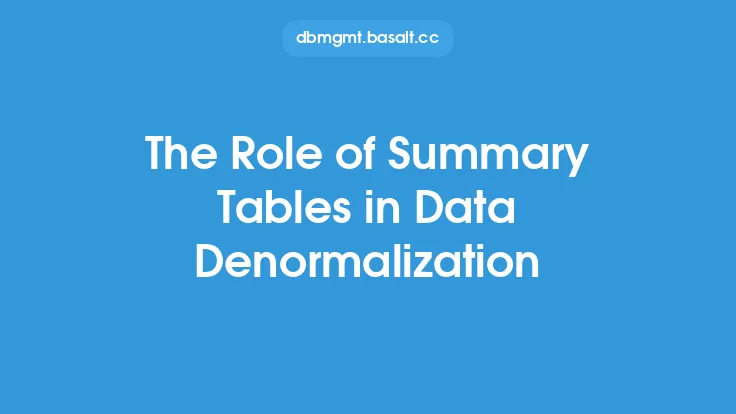Data denormalization is a crucial aspect of data warehousing, as it enables the optimization of data storage and retrieval for analytical purposes. In a normalized database, data is organized to minimize data redundancy and improve data integrity. However, this can lead to complex queries and slower performance when dealing with large amounts of data. Data denormalization, on the other hand, involves intentionally duplicating data to improve query performance and reduce the complexity of queries.
Introduction to Data Denormalization
Data denormalization is a technique used to optimize data storage and retrieval in a data warehouse. It involves denormalizing data to improve query performance, reduce data redundancy, and simplify complex queries. Data denormalization is essential in data warehousing, as it enables the creation of a data structure that is optimized for analytical purposes. There are several types of data denormalization, including pre-joining tables, pre-aggregating data, and using summary tables.
The Role of Data Warehousing in Data Denormalization
Data warehousing plays a critical role in data denormalization, as it provides a platform for storing and managing large amounts of data. A data warehouse is a centralized repository that stores data from various sources, making it possible to analyze and report on data from different systems. Data warehousing involves the extraction, transformation, and loading (ETL) of data from various sources into a single repository. This process enables the creation of a unified view of data, which is essential for data analysis and reporting.
Data Denormalization Techniques
There are several data denormalization techniques used in data warehousing, including:
- Pre-joining tables: This involves joining tables before storing them in the data warehouse. This technique reduces the complexity of queries and improves query performance.
- Pre-aggregating data: This involves aggregating data before storing it in the data warehouse. This technique reduces the amount of data that needs to be processed and improves query performance.
- Using summary tables: This involves creating summary tables that contain aggregated data. This technique reduces the amount of data that needs to be processed and improves query performance.
Benefits of Data Denormalization
Data denormalization offers several benefits, including:
- Improved query performance: Data denormalization reduces the complexity of queries and improves query performance.
- Reduced data redundancy: Data denormalization reduces data redundancy by eliminating the need to join tables or aggregate data.
- Simplified complex queries: Data denormalization simplifies complex queries by pre-joining tables or pre-aggregating data.
Challenges of Data Denormalization
Data denormalization also presents several challenges, including:
- Data inconsistency: Data denormalization can lead to data inconsistency, as data is duplicated across multiple tables.
- Data maintenance: Data denormalization requires regular data maintenance to ensure that data is up-to-date and consistent.
- Data storage: Data denormalization requires additional data storage, as data is duplicated across multiple tables.
Best Practices for Data Denormalization
To ensure effective data denormalization, several best practices should be followed, including:
- Identify the most frequently accessed data: Identify the most frequently accessed data and denormalize it to improve query performance.
- Use data denormalization techniques: Use data denormalization techniques, such as pre-joining tables or pre-aggregating data, to simplify complex queries and improve query performance.
- Monitor data consistency: Monitor data consistency to ensure that data is up-to-date and consistent across multiple tables.
- Regularly maintain data: Regularly maintain data to ensure that it is up-to-date and consistent.
Conclusion
Data denormalization is a critical aspect of data warehousing, as it enables the optimization of data storage and retrieval for analytical purposes. By using data denormalization techniques, such as pre-joining tables or pre-aggregating data, data warehousing can improve query performance, reduce data redundancy, and simplify complex queries. However, data denormalization also presents several challenges, including data inconsistency, data maintenance, and data storage. To ensure effective data denormalization, several best practices should be followed, including identifying the most frequently accessed data, using data denormalization techniques, monitoring data consistency, and regularly maintaining data. By following these best practices, organizations can ensure that their data warehouse is optimized for analytical purposes and provides accurate and consistent data for decision-making.





